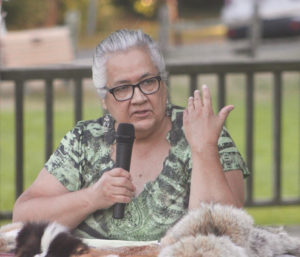EASTHAM — Since 1620, the English side of the story of the Pilgrims’ landing at First Encounter Beach, and then Plymouth, has been the version most people learn in these parts. Which means, during those 400 years, many elements have been missing from the narrative.
This year, the celebrations of this milestone have taken on the task of setting the record straight, looking to include the Wampanoag tribe’s experience.
“Our goal was to make it more about the whole story, rather than just the Pilgrims,” according to John Hanlon, who brings an extensive background in local education to the Eastham 400 project.
Hanlon, a Harwich resident, was approached by Tom Ryan of the Eastham 400 Commemoration Committee to work on the Sunset Series and Campfire Series programs with Nauset High graduate Joanna Holleck, now a sophomore at Gettysburg College. Hanlon has been a campfire organizer for the Cape Cod National Seashore, taught in the Provincetown Schools for 20 years, and is the manager for the Building Pathways for Tribal Youth program of the Mashpee Wampanoag Tribe Education Dept.
Holleck, a Brewster native, was the coordinator for the Sunset Series video presentations. The 10-minute programs have been posted on the Eastham 400 website every evening since June 1, and will continue through Sept. 7. The Campfire Series features hour-long programs hosted by Hanlon. All of these programs were meant to be held at First Encounter Beach this summer, but were switched online due to Covid-19 concerns.
One of the Campfire programs, focusing on the Wampanoag tribe, was held in person this past Sunday at the Eastham Windmill Green, with an encore presentation this Sunday, Aug. 30, at 6 p.m. It will be online, too. Pre-registration is required.
About a third of the programming in both series has focused on the Wampanoags. Hanlon opens the Campfire program this way: “Four hundred years later, those of us on Cape Cod still face the same issues — what is it like to be an immigrant here? How do the native people feel about our presence? How have humans impacted this area in 400 years? And how has the landscape changed?”

To answer these questions, Hanlon called on members of the Indigenous community, including Earl Mills Jr., Linda Coombs, and students from the Mashpee Wampanoag Tribe education program.
Mills, who was featured in the Aug. 9 Campfire program, is the son of Chief Flying Eagle of the Mashpee Wampanoags, and is one of the group known as the “Mashpee Nine,” who were all arrested for disturbing the peace after a community celebration in 1975.
Mills closed his interview by reading the Wampanoag statement that led to that arrest. Frank James, a former Nauset High music teacher, had been invited by then-governor Frank Sargent to speak during the Mayflower 350th anniversary celebration in 1970. James’s commentary was an indictment of the Pilgrims, citing robbery of food and the arrival of disease, and calling for Indians to regain their rightful place. After organizers read his draft, James was barred from the program. That’s when he established the national Day of Mourning for American Indians in Plymouth.
“He’s such a humble guy,” Hanlon said of Mills. “He worked with me last year on a program with the kids, identifying medicinal plants.” That’s when Hanlon asked Mills to connect the Mashpee Nine experience with what’s going on now.
Coombs, who spoke during Sunday’s program, is an author and historian from the Wampanoag Tribe of Aquinnah on Martha’s Vineyard. She worked for nearly three decades with the Wampanoag Indigenous Program at Plimoth Plantation, including 15 years as the program’s associate director. She’s now the program director of the Aquinnah Cultural Center.
Coombs spoke of Maushop, regarded as a transformer in Wampanoag history. According to legend, Maushop left the mid-Cape area for Aquinnah, when the cliffs there, known now for their colors, were white. He would kill whales to feed the people and, to do so, he would grab the whales by the tail, and smack them against the cliff. The blood, it’s said, turned the sand red. The black soot from his cooking fires turned the sand gray.
Coombs explained that she refers to these as more than legends, as history. A visiting geologist who spoke at the Aquinnah Cultural Center was skeptical. “That’s not real; those are just fables,” he told her. Coombs said, “I told him the one about the blood of the whale and the ashes, and he goes, ‘Well, in the red clay there is an element that is akin to blood, and the black was another element like charcoal.’ I was like, ‘See?! I told you they were real!’ ”
Many of the Sunset programs have featured Wampanoag arts, regalia, and family structures, revival of the Wampanoag language, and relationships between the Nauset and English in 1620. The Sunset and Campfire programs can be viewed at easthamfirstencounter.org.
The final Campfire, featuring John Hanlon and Linda Coombs, will be held at the Windmill Green on Sunday, Aug. 30, at 6 p.m. Pre-register at easthamfirstencounter.org.
